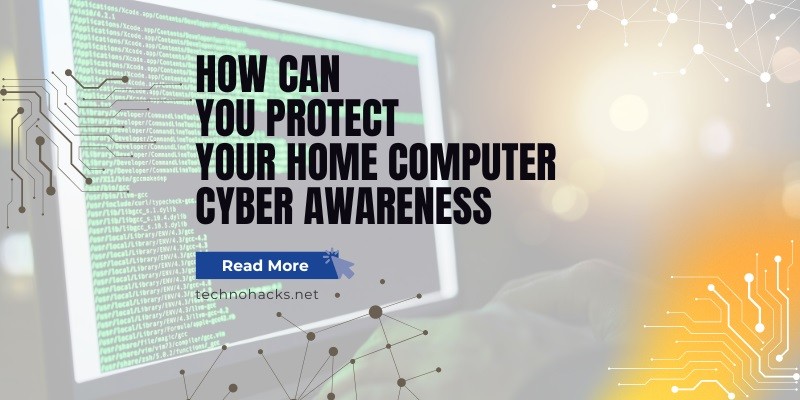Last Updated on May 5, 2025 by Jim C.
In today’s digital age, protecting your home computer and maintaining cyber awareness is more crucial than ever. With cyber threats constantly evolving, it’s essential to stay informed and take proactive measures to safeguard your personal information and digital assets. This article will explore various aspects of home computer security and provide practical tips to enhance your cyber awareness.
Common Cyber Threats
To effectively protect your home computer, it’s important to understand the types of threats you may encounter. Cybercriminals employ various tactics to compromise your system and steal sensitive information.
Malware: This broad category includes viruses, trojans, and ransomware. These malicious programs can infect your computer, causing damage to your files, stealing personal information, or even holding your data hostage. In 2023 alone, there were over 800 publicly disclosed global security incidents, resulting in an estimated 4.5 billion breached records.
Phishing attacks: Cybercriminals often masquerade as trustworthy entities to steal sensitive financial or personal information through fraudulent emails or messages. Phishing attacks remain one of the most successful methods for data breaches.
Identity theft: Hackers and online predators may attempt to steal your personal information to commit fraud or other crimes in your name.
Unsecured networks: Public Wi-Fi networks and improperly secured home networks can leave your devices vulnerable to attacks.
Essential Security Measures
Implementing robust security measures is crucial for protecting your home computer. Here are some key steps to enhance your cybersecurity:
Keep your system updated: Regularly updating your operating system and software is one of the most effective ways to protect against cyber threats. Enable auto-update features when available, or manually update on a monthly basis at minimum. A 2022 Ponemon Institute report found that unpatched vulnerabilities were the source of 80% of successful breaches.
Use strong authentication: Create strong, unique passwords for each of your accounts. Implement multi-factor authentication whenever possible to add an extra layer of security.
Install and maintain antivirus software: Use a comprehensive security suite that provides real-time protection against malware, phishing attempts, and other threats. Ensure your antivirus software is regularly updated to defend against the latest threats.
Enable firewall protection: Utilize both built-in operating system firewalls and consider third-party firewall options for additional protection.
Safe Browsing Practices
Adopting safe browsing habits is essential for maintaining your online security:
Use secure websites: Always look for the “https” prefix and padlock icon in your browser’s address bar when visiting websites, especially those requiring personal information.
Avoid suspicious links and downloads: Be cautious when clicking on links or downloading attachments, particularly from unknown sources.
Exercise caution with email attachments: Verify the sender’s identity and scan attachments for malware before opening them.
Securing Your Home Network
Your home network is the first line of defense against cyber threats. Take these steps to secure it:
Change default router passwords: Use a strong, unique password for your router’s admin account.
Enable WPA3 encryption: This latest Wi-Fi security protocol offers enhanced protection for your wireless network.
Set up a guest network: Create a separate network for visitors to keep your main network secure.
Data Backup and Recovery
Regular backups are crucial for protecting your data in case of a cyber attack or system failure:
Implement regular backups: Use external hard drives or cloud storage solutions to back up your important files.
Test restore procedures: Periodically verify that you can successfully restore your data from backups.
Educating Family Members
Cybersecurity is a family affair. Ensure all household members are aware of potential threats and best practices:
Share cybersecurity best practices: Educate family members about safe online behavior and the importance of protecting personal information.
Set up parental controls: Implement age-appropriate restrictions for children’s online activities.
Create a family internet usage policy: Establish guidelines for safe and responsible internet use within your household.
Additional Security Tools and Practices
Consider implementing these additional measures to further enhance your home computer security:
Virtual Private Networks (VPNs): Use a VPN to encrypt your internet connection, especially when using public Wi-Fi networks.
Password managers: Utilize a reputable password manager to generate and store strong, unique passwords for all your accounts.
Ad-blockers and privacy-focused browser extensions: These tools can help protect your privacy and reduce the risk of malvertising attacks.
Staying Informed
Cyber threats are constantly evolving, making it crucial to stay informed about the latest security trends and best practices:
Follow cybersecurity news: Stay up-to-date with the latest threats and security recommendations from reputable sources.
Participate in Cybersecurity Awareness Month: Take advantage of educational resources and events offered during this annual observance.
Conclusion
Protecting your home computer and maintaining cyber awareness requires ongoing effort and vigilance. By implementing the security measures outlined in this article, you can significantly reduce your risk of falling victim to cyber-attacks. Remember to keep your systems updated, use strong authentication methods, practice safe browsing habits, and educate your family members about cybersecurity best practices.

